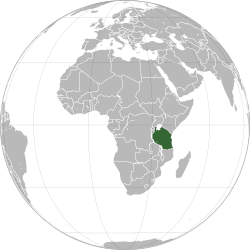Tanganyika (1961–1964)
This article has multiple issues. Please help improve it or discuss these issues on the talk page. (Learn how and when to remove these template messages)
|
Tanganyika (1961–1962) Republic of Tanganyika (1962–1964) Jamhuri ya Tanganyika (Swahili) | |||||||||
|---|---|---|---|---|---|---|---|---|---|
| 1961–1964 | |||||||||
 | |||||||||
| Capital | Dar es Salaam | ||||||||
| Common languages | |||||||||
dominant-party assembly-independent republic (1962–1964) | |||||||||
| Head of State | |||||||||
• 1961–1962 | Elizabeth II (Monarch) | ||||||||
• 1962–1964 | Julius Nyerere (President) | ||||||||
Richard Turnbull | |||||||||
Prime Minister | |||||||||
• 1961–1962 | Julius Nyerere (first) | ||||||||
• 1962 | Rashidi Kawawa (Last) | ||||||||
| History | |||||||||
• Independence from British Empire | 9 December 1961 | ||||||||
• Republic | 9 December 1962 | ||||||||
• Union with Zanzibar | 26 April 1964 | ||||||||
| Area | |||||||||
• Total | 944,842 km2 (364,806 sq mi) | ||||||||
| Currency | East African shilling | ||||||||
| |||||||||
| Today part of | Tanzania | ||||||||
Tanganyika (
History
Tanganyika originally consisted of the
| Tanganyika Independence Act 1961 | |
|---|---|
| Act of Parliament | |
 | |
Status: Amended | |
| Text of statute as originally enacted | |
| Text of the Tanganyika Independence Act 1961 as in force today (including any amendments) within the United Kingdom, from legislation.gov.uk. |
The Tanganyika Independence Act 1961 (
Tanganyika adopted a new constitution in 1962 that abolished the monarchy, and the National Assembly (the majority of whom were members of the Tanganyika African National Union Party) thoroughly revised the new constitution to favour a strong executive branch of government, namely a president.[3] Tanganyika then became a republic within the Commonwealth of Nations, with Julius Nyerere as the President of Tanganyika. After the Union of Zanzibar and Tanganyika, an interim constitution adapted from the 1962 Constitution became the governing document. Although meant to be temporary, the constitutions remained effective until 1977.[3]
The unification of Tanganyika and Zanzibar in 1964 followed Nyerere's principle of Ujamaa which entailed a strong "territorial nationalism."[4]
See also
References
- .
- ^ The Union of Tanganyika and Zanzibar Act, 1964 (Act No. 22 of 1964). Archived from the original on 5 March 2022. Retrieved 5 March 2022 – via WIPO IP Portal.
- ^ a b c Katundu, Mangasini Atanasi; Kumburu, Neema Penance (2015). "Tanzania's Constitutional Reform Predicament and the Survival of the Tanganyika and Zanzibar Union" (PDF). The Journal of Pan African Studies. 8 (3): 104–118. Archived (PDF) from the original on 16 June 2022. Retrieved 5 March 2022.
- from the original on 26 April 2019. Retrieved 4 October 2016.



